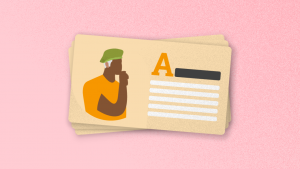Technology has evolved so much and so fast in the last decade that it changed over and over how we think about Digital Marketing.
Today, data and automation are at the center of any strategy that aims to convert more and spend less. It is all about optimizing costs and engaging the right people at the right time.
In this email marketing guide, we want to show you exactly how a well-structured campaign can use this consolidated channel to attract, gather data, advertise, and build brand presence. All of that relying heavily on cheap, easy and automatic tools.
Keep on reading to discover more about the following topics:
- Email: Standing the Test of Time
- What is Email Marketing?
- How Does Email Marketing Work?
- The Importance of an Email Marketing Strategy
- Is Email Marketing Still Effective?
- Types of Marketing Emails
- How to Start an Email Marketing Strategy
- Building an Email Marketing Flow
- How to Write a Marketing Email
- 9 of the Best Email Marketing Tools
- 7 Email Marketing Metrics to Keep an Eye on
- How to Measure the Results of Email Marketing Campaigns
- Email Retargeting: Reconnecting With Inactive Subscribers and Boosting Engagement
- Email Campaign Case Studies: Real-Life Examples of Successful Email Marketing Strategies
- Email Marketing Trends for 2024: Emerging Strategies and Techniques to Stay Ahead
- Wrap Up
Email: Standing the Test of Time
When we think about how much communication has changed since the internet became popular, we realize that email is an outlier.
We have seen the quick rise and fall of chat rooms and instant messaging, and the constant mutation of social networks from Myspace to Twitter.
People are abandoning all of that due to visual networks, such as Instagram or TikTok, and group chats, like Telegram and Zoom.
But even with so many changes, email still is a primordial and popular way of communicating, almost the same as it was when invented in the late 1970s.
Why so?
The answer is simple: email is the most efficient, direct, and organized way of sending messages — especially for sharing documents, keeping track of orders online, and being well informed.
Because of that, email is reliable. People trust and pay attention to it. And that is a giant value for marketing campaigns.
What is Email Marketing?
Email marketing is a strategy for offering rich, smart, and relevant content directly to your leads via their inboxes.
It is an approach to build a long-term relationship by constantly contacting them in meaningful ways.
This plan can be adapted depending on what your audience expects from your brand. It can be a conversation, with articles and tips about subjects aligned with their interests.
Or it can also be informative, with updates about the company, including orders or loyalty programs. It usually is a bit of both.
In its core, email marketing is a structure based on planning, timing, and automation. It can be used to:
- Raise brand awareness.
- Promote rich and relevant content.
- Build authority.
- Generate and nurture leads and get richer data from them.
- Market new products.
- Retain converted leads boosting brand loyalty.
How Does Email Marketing Work?
Usually, email marketing is heavily focused on automation. The most common approach to this strategy is to plan a calendar and write content that will fit in it.
Then, the company uses tools to create triggers that activate certain actions and send the right message at the most appropriate time.
How about an example? Let’s say your company sells shoes and has an amazing ebook about different models and when to use them.
Your lead is interested in it and curious, so they give you their email address to get access to the content. That’s a trigger.
When activated, the automated tool immediately sends them not only the link to the ebook but also another article about pairing shoes with the right socks.
A week later — a time trigger —, you ask about their reading and start showing more rich information.
Or you start talking about what sets your shoes apart from other brands. Maybe they go well with anything. Maybe they match the lead’s style.
Now you have created a connection, a relationship. That is the power of email as a marketing channel.
It talks directly to the lead, and it is constant. These are two amazing key points for a successful advertising campaign.
It was only a simple example, but it shows a little about how it can boost your brand awareness and your sales.
The Importance of an Email Marketing Strategy
Let’s talk a bit more about the benefits that make companies from startups to enterprises invest in email marketing.
Nearly everybody has an email
And that it is not just an assumption.
Researches point out that more than 90% of the US population has an account, and most of them check their inboxes daily.
Email Marketing ROI is better
Email marketing already starts from a vantage point for marketing. If you have the lead’s email, they are already engaged in a buyer’s journey towards you.
This information alone tells us that email gives a lot more return over your investment compared to other kinds of advertising and marketing.
With a great strategy, your conversion ratio can be a lot better than paid ads or other more general ways of attracting leads.
Emails are cheap
We can’t forget to talk about costs.
As we said, automation plays a big part in the execution of email marketing. When it is set up and ready to launch, the campaign works almost by itself.
The only money you spend is on tools and services that will keep it running. The human effort will be focused on analyzing KPIs and fine-tuning the message.
So you can easily plan a strategy that uses automation to be on 24/7, in a cheap and very effective way.
All of this in a channel capable of reaching almost all your leads and client base.
Is Email Marketing Still Effective?
The short answer is yes, email marketing is still effective. However, it’s imperative to think of email lists as a tool, not a magic wand. Just because you email a subscriber list doesn’t mean anything will happen.
Typically, the value of your email list depends on the work you put into it. If you just send generic emails to subscribers and never update your list, it’s not very useful. However, if you take the time to curate content and engage with your subscribers, your list can become marketing gold.
Below are some statistics of how well email marketing can help your business in 2024 and beyond.
- Email marketing revenue is projected to reach $11 billion by the end of 2024.
- There are over four billion email users globally.
- Subscriber segmentation is the most effective email marketing strategy (78 percent effective), according to marketers.
- Seventy-seven percent of marketers have seen an increase in email engagement from 2022 to 2023.
- Fridays generally see the highest open rates, while Saturdays have the lowest.
- A majority of B2B brands (64 percent) say email marketing helped them achieve their goals.
- Most views come from mobile devices (41 percent), with desktop devices a close second (38 percent).
- Almost half (46 percent) of mobile users say they prefer emails from brands instead of other messaging channels (i.e., SMS or phone calls).
As you can see, there is a lot of value in email marketing. Again, the more effort you put into your strategy, the better your ROI. As with anything else, it’s a tool to help you achieve specific goals.
Types of Marketing Emails
Naturally, not all marketing email is the same. There are many effective options to choose from when it comes to connecting with your contacts in the right ways at the correct times.
Here are just a few key email marketing examples every marketer should know.
Newsletters
If you manage a business blog, online publication, or any other type of site that deals in regular content updates, a newsletter is a must.
Not only are newsletters experiencing a major comeback right now, but they’re efficient ways to ensure your readers don’t miss out on your most important content.
Announcements
People opt into your email advertising updates for a reason.
They like what you’re doing and want to stay in the know regarding anything new you might do, so most will expect occasional announcements.
These can be about new products or significant updates to existing ones, especially those a recipient may have purchased or otherwise engaged with.
Dedicated Sends
Although occasional general emails that go out to your whole contact list are fine, sends that go out to specific segments of your customer base instead are also a good idea.
This is a great way to personalize your email marketing efforts, as well as nurture leads who may occupy different positions within your marketing funnel.
Confirmation Emails
If you’ve ever completed a purchase or otherwise made a particular transaction online and not received a confirmation email, then you already know how frustrating that can be.
It’s all too easy to wonder if everything went through OK, so don’t leave your customers hanging. Confirmations and “thank you” emails are part of thorough email marketing, too.
How to Start an Email Marketing Strategy
A successful email marketing strategy is all about planning and structuring.
So let’s list the steps you need to follow so you can guarantee a great response from the audience since the first mail sent.
1. Start with your goals
Like any other marketing campaign, you can’t trace a path without knowing where the end line is.
So let’s begin with some achievable but bold goals.
What do you want the most? Is it converting more leads that you attract? Is it creating brand awareness? Is it focusing on brand loyalty?
Usually, you can work on all of these points together. But each one of them needs its own plan and ways of measuring success.
2. Create content
One thought about email strategy is that you need to have content ready before running it.
Well, not all of it, but enough to cover needs, expectations, and doubts in all stages of the Digital Marketing funnel.
Your emails need to be coherent with your buyer persona. They need a similar voice and style and must communicate in a way familiar to your audience.
Remember, you are creating a relationship.
Writing emails for a campaign involves conversations, information, updates, and system messages. It’s a lot to elaborate on and format.
3. Setup your triggers
With content ready, the next step is all about predicting the audience’s behavior and setting up the structure accordingly.
Triggers are conditions that drive to action.
If the lead visited a store page for sneakers while logged, then the software sends him tomorrow an email with a discount for those.
If they didn’t visit the store for a month, then an email can let him know of new models and make offers. A trigger can be action based or time-based.
That’s why knowing your buyer persona is so important. You need to understand how they react to stimulation, how they engage with content, and what motivates their buying impulse.
The triggers will be the center of your strategy because email marketing doesn’t work as it should without automation. Imagine having to send them manually!
4. Build your mailing list
Usually, an email marketing address list starts with the ones you already have from login information.
One of the main efforts related to this strategy is how to get new and fresh addresses with which you can build a relationship.
A great way of doing that is by offering something in exchange for contact information.
For example, ebooks, tutorials, rich data, and webinars are attractive material that grabs the persona’s attention and is valuable enough to make them willingly share info with you.
You need to build your list organically, looking for people who want to be contacted by you. The golden rule here is never to buy an email marketing list!
5. Segment your mailing list
If you are doing it right, your company will have thousands of email addresses to feed the automated marketing campaign.
But you wouldn’t want to send the same content to all of them, right?
Some leads are yet in the discovery stage. They don’t even know for sure what they want. Others are about to make a buying decision. Another portion of them includes clients who are looking for a new discount.
So it is important to create segments within your list and different paths and triggers for each one.
That way, you can distribute your content right and be laser-focused with your message.
6. Know the dos and don’ts
A list, structure, content, and goals: that’s all you need to start a great email marketing campaign.
But we want to give you some additional tips that may optimize your work. See what you have to do and what you have to avoid.
Let’s start with the dos:
- Always give some reward in each email — for example, an interesting article or a discount coupon.
- Be a constant presence, so the brand is always remembered.
- Create a newsletter to improve your strategy and build a deeper connection.
- Finish emails creating some excitement or expectation for the next one.
- Always deliver what you promise.
And now the don’ts:
- Don’t be inconvenient, both on content and frequency.
- Never send emails to people who didn’t authorize you to do so.
- Don’t buy email lists — they can boost your reach, but will never translate well into conversions.
- Never lie or deceive your leads with misleading messages.
7. Conduct A/B testing for email marketing
Getting an email marketing strategy right involves some trial and error, especially when handling the finer details like wording and formatting. That’s where A/B testing (sometimes called split testing) comes in.
A/B testing involves sending out two or more versions of the same email to determine whether one approach performs better. Examples of elements a marketer might want to test include:
- Different subject lines or approaches to the actual copy
- Various CTA styles
- Send times for different kinds of blasts
- Different methods for incorporating links
- Use of emoji, graphics, moving visuals, etc.
For best results, focus on one element at a time when conducting A/B testing so you know exactly what’s driving your results.
Building an Email Marketing Flow
Understanding the value of email marketing is only the first step. Now, you have to take that knowledge and turn it into actionable steps to achieve your goals. Here are some best practices to follow for building an email flow from scratch, no matter your skill or experience level.
Start with compelling calls to action (CTAs)
The first step to creating an email marketing list is to capture emails from willing individuals. While it’s relatively easy to give out one’s email address, there are also tons of reasons not to. So, you must create a compelling call to action to motivate someone to follow through and sign up.
Typically, the best way to get more subscribers is to offer something, ideally for free. Perhaps you send out an insightful newsletter, or maybe you offer exclusive discounts on products and services to subscribers. The more value the return, the more likely someone will sign up.
That said, your calls to action should be customized to fit each landing page. This way, the CTA matches the visitor’s expectations and is more compelling than a generic sign-up form. For example, on a product landing page, it may be best to offer discounts. On the home page, you may choose to address specific problems or challenges a visitor may be facing.
Overall, curating your CTAs will help you build a list faster.
Make your first email as captivating as possible
One of the primary challenges of making email marketing work is that you need to inspire action after someone subscribes to your list. Low open rates are common, so email marketing has become something of a numbers game.
However, there is one email that gets the most attention and often gets opened immediately—the welcome email. Depending on the situation, an average open rate is about 30 percent, although it can be as high as 50 or 70 percent, depending on the value of that email.
Basically, you need to create an automatic welcome email that gives your new subscriber a sense of what to expect. You can also include a few links or survey responses to help you with curation (more on that next). No matter what, you only get on chance to send a welcome email, so treat it as a valuable piece of content.
Curate your email list from the beginning
Realistically, everyone on your email list wants something unique from your business. Some people are after coupons, while others want content and insight. So, if you send the same emails to everyone on the list, you’ll dilute the amount of engagement.
Instead, it’s better to segment and curate your list from the beginning. For example, if someone subscribes from a particular landing page, they can go on a list. Similarly, clicking a link or button in the welcome email can put them on a separate list.
Because email lists can get overwhelming quickly, you need to automate curation as much as possible. By doing this from the beginning, managing your segments more effectively is much easier.
Tailor content for each segment of your list
Segmenting your subscribers enables you to improve your open and click rates as long as you customize the content each list receives. While creating multiple content pieces for each segment can take longer, the ROI is much higher overall. Also, keep in mind that some subscribers may be on multiple lists, so it doesn’t make sense to send them the same content each time. Otherwise, they’re more likely to unsubscribe altogether.
Update and revise your list as you go
As you send emails out to your subscribers, you’ll be able to gather data on each campaign. Based on this data, you can tell which of your subscribers is the most active and engaged. Sometimes, you’ll move someone onto a new segment. Other times, you may have to focus on retargeting inactive users to get them to open your messages.
Overall, you want to curate your lists regularly. This way, you’re not wasting time on inactive emails, and you can improve your open rate for each segment. Thankfully, automation can take care of a lot of this, although you should still monitor your list manually as well.
How to Write a Marketing Email
Understanding how to use email marketing and why it’s important is one thing. But creating an effective email that inspires people to open, read, and act on it is another.
Here are some expert tips to know.
1. Write subject lines that are clear first and catchy second
Most email marketers understand the importance of helping their emails stand out and grab a recipient’s attention.
But it’s important not to focus so much on making things snappy and catchy that you leave simple clarity in the dust.
Great email marketing means ensuring your subject line accurately tells a recipient precisely what they can expect to see if they open it.
Then you can think about tweaking it to pique the person’s curiosity a little.
2. Ensure your copy delivers on your subject line’s promise
An effective subject line doesn’t just tell a reader what to expect. It also makes them a promise.
This may be a promise to entertain, inform, inspire, or something else entirely, but your copy needs to deliver on whatever it is.
This is about more than simply being responsible with your email advertising.
When people open a marketing email and don’t get what was promised, click-through rates take a nosedive. And without those clicks, the email itself doesn’t serve much purpose.
3. Use the second person when writing copy
Readers respond best to marketing material when it doesn’t sound much like marketing at all.
Consumers also like to feel like they have a personal connection with the brands they buy from. Writing your email copy in the second person is a great way to tick off both of those boxes.
Overusing the third person (he/she/it) in a marketing email can create a strange disconnect between the sender and the reader. Meanwhile, too much first person (I/we) focuses all the attention on the sender.
However, the second person (you/you guys) brings the focus back to where it will have the most impact — the reader.
4. Establish relevancy early
Your readers are busy people, so the last thing you want to do once you’ve got their attention is waste their time.
Effective email marketing opens with what the reader wants to know right off the bat — why they’re being contacted and what it has to do with them.
So what does your email want the reader to know, and why should they care? Is a product they absolutely love on sale right now? Are you letting them know a much-anticipated site or blog update is now live?
Lead with that. Then briefly follow up with any additional information you want to communicate before closing with a strong call-to-action.
5. Create benefit-oriented copy
As the brand behind the email, you naturally know what your reader stands to gain if they open, read, and engage with your content.
The purpose of your copy is to successfully convey that value to them and inspire them to click through once they’re done reading.
Many brands attempt to do this by outlining the features associated with their offer. They tell the reader what they’re getting (e.g., a discount, a special offer, or access to an upgrade).
However, they fail to tell them why they should want whatever it is.
Ultimately, consumers purchase experiences, benefits, and lifestyle perks more than they do products.
Orienting your email marketing copy toward the benefits a product brings to the table shows your reader how their life will change for the better if they respond to your call-to-action.
6. Keep it brief
Think back to the last time you opened a marketing email from a brand you buy from or have otherwise shown interest in.
If you’re like most people, you didn’t sit there and read every single word of the copy. You likely skimmed it quickly to get the gist of the key elements at a glance, right?
Your readers are the same way, so craft your emails with this in mind. Resist the urge to write paragraph after paragraph of copy.
Instead, keep things brief, make your points quickly, and focus on generating skimmable content.
Otherwise, you risk confusing or frustrating your reader to the point where they won’t click through on your offer.
7. Infuse your personality into your email
Yes, great marketing emails should get to the point and be informative. But it’s possible to make them those things while also conveying warmth, friendliness, and a bit of your unique personality.
Being human and friendly helps a reader make that personal connection to your brand and increases the chance that they’ll interact with you further.
Remember, today’s consumers want and expect the brands they do business with to act, communicate, and feel like friends.
Humanize your brand by using humor, slang, and so forth in your messages — just as you would if you were communicating with a close friend or loved one.
8. Choose your call-to-action language carefully
Marketing emails should always have a point — something specific you would like your reader to do once they’ve finished absorbing the information you’ve sent.
Whatever it is should be clearly and concisely conveyed in your closing call-to-action.
Use clear, actionable language in your CTA. And make sure it stands out so that the many people who will simply skim your email won’t miss it. (Eye-catching design elements like clickable buttons are just one great way to do this.)
However, while graphics and images are great ways to add visual interest to your emails and help the reader zero in on what’s most important, you don’t want to over-rely on them.
Some email clients may not render your images properly (or at all), so your messages still need to scan well without them.
9. Create eye-catching and responsive emails
In 2024, it’s estimated that the average person receives between 40 and 120 emails daily. Even toward the lower end of that range, that’s a lot of emails, so yours need to stand out if you’re serious about getting people’s attention.
Focus on creating innovative, dynamic mail that catches the eye and piques people’s curiosity. Some tips for doing that include:
- Using visuals like videos, graphics, and similar elements to break up text
- Personalizing email to add warmth and help people connect
- Create subject lines that grab attention while also highlighting the content of the email
- Ensure everything about your message underscores your unique brand identity, including humor, colors, fonts, and wording
It’s also crucial that your emails be fully responsive so recipients can easily read them via various devices. Ensure all visual elements load well and look good before finalizing your blasts.
9 of the Best Email Marketing Tools
It is now clear that technology has a huge part in email marketing.
Automation, intelligence, and data analysis are constant demands for creating and improving campaigns.
So what you need is to choose the right ones. You do that by betting on products and services that integrate content creation, trigger and structure planning, and performance monitoring.
Take a look at the best tools on the market!
1. Mailchimp
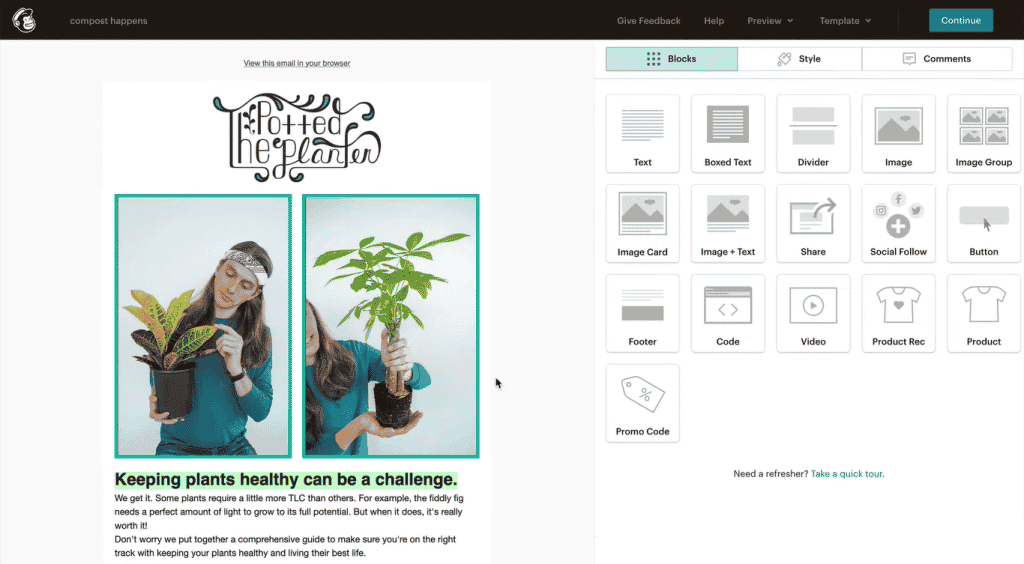
Mailchimp is one of the most popular and complete email marketing platforms, and it offers free plans for those who still have a small email list.
You can use it for everything: manage email addresses, elaborate content, build email layouts, set triggers, segment messages, and even analyze results.
2. Constant Contact
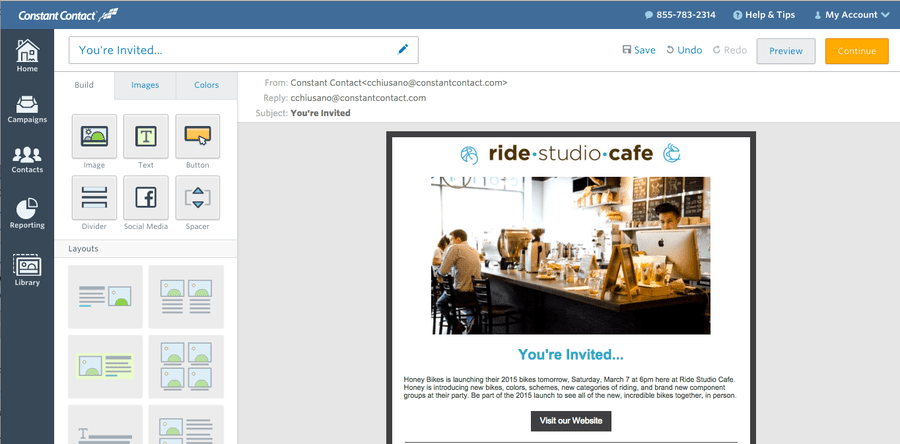
Constant Contact is a similar platform that helps even small businesses on creating great email marketing campaigns with low investment.
When we say low, we are talking about $20 a month for unlimited emails, customizable templates, mobile responsive layouts, everything with an easy and intuitive interface for planning, producing, and measuring.
3. Keap
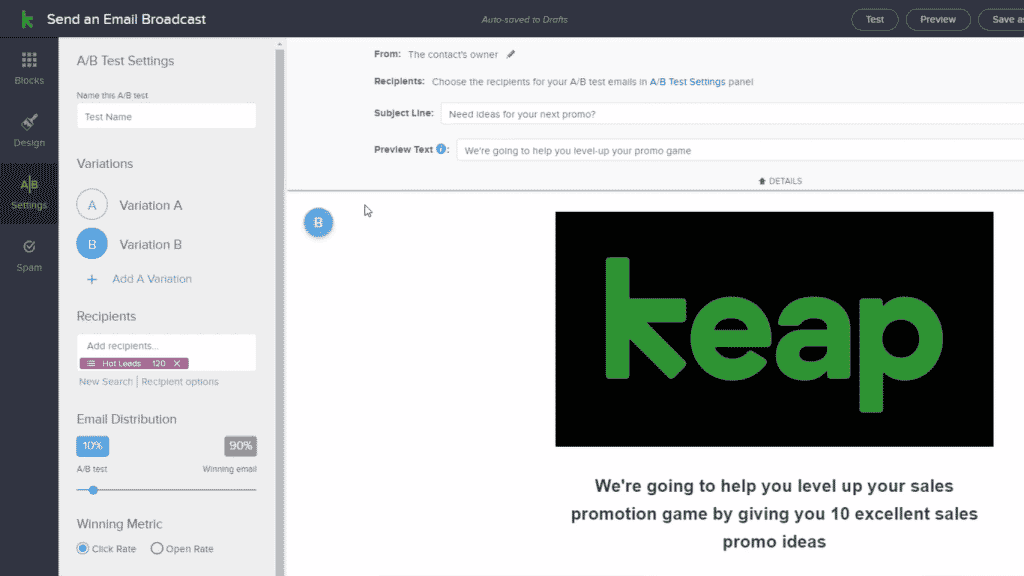
Every company can use the same structure created for email marketing as a sales and CRM tool. Keap is a service that does exactly that.
With the platform, you can program your campaign, but also automate relationships with customers.
It’s a perfect way of integrating marketing and sales into a killer strategy.
4. Sendinblue
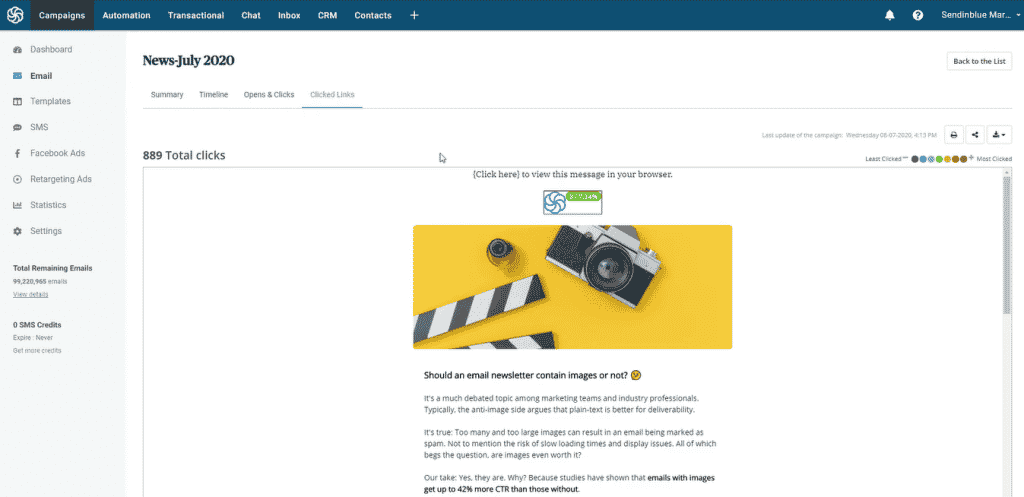
If you’re looking for email marketing software designed with a small business’s needs in mind, Sendinblue is a must.
It’s ideal for launching and managing simpler campaigns on a smaller scale. However, it also comes complete with all the features you need to make your campaigns successful.
Think live chat, SMS support, and more.
5. HubSpot
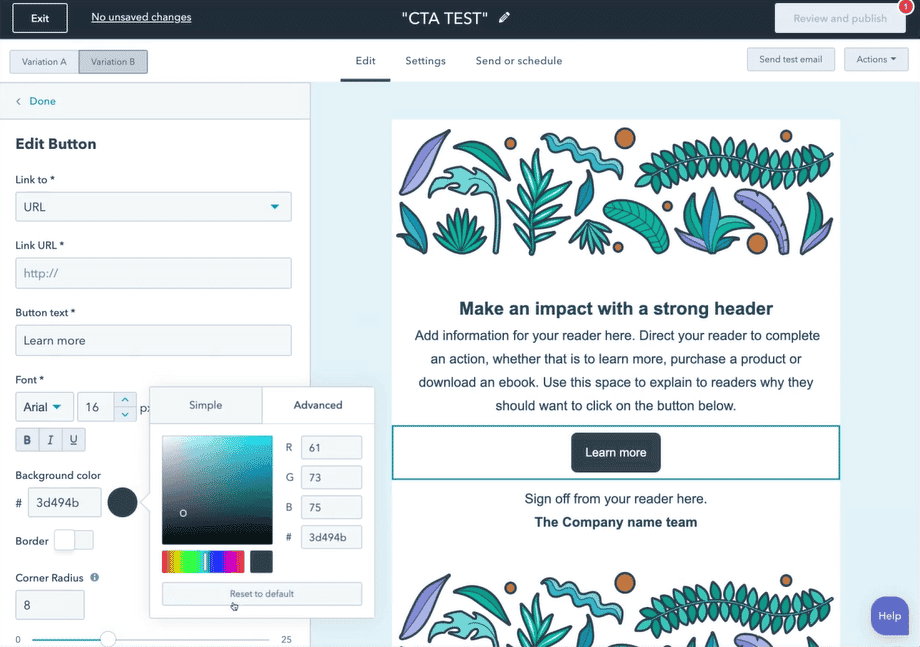
If you’re looking into email marketing services that are powered by customer relationship management data (CRM), definitely check out HubSpot.
HubSpot features a simple interface that makes crafting beautiful, personalized emails easy.
You’ll also gain access to a full suite of options designed to take the guesswork out of optimizing your campaigns, like A/B testing, extensive reporting, and more.
6. Drip
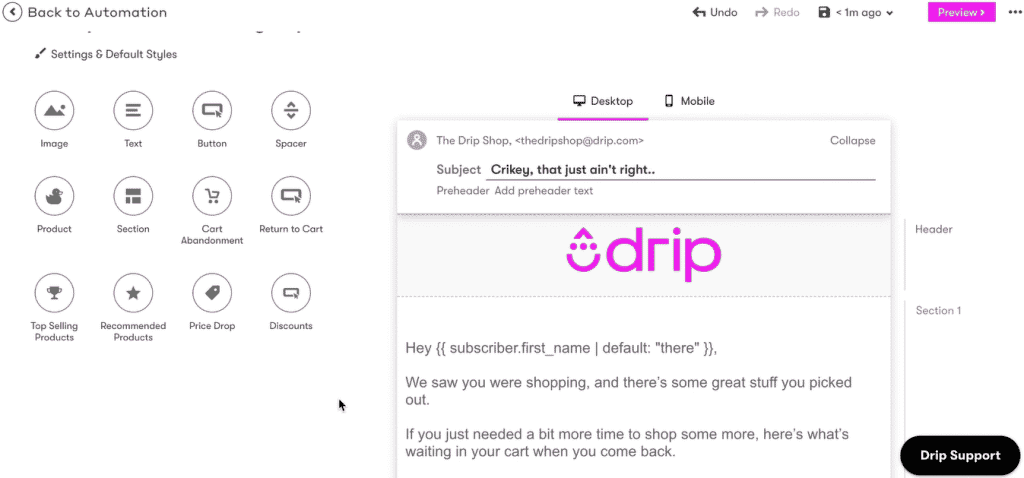
Drip is a solid option for e-commerce marketers looking to take their email marketing efforts to the next level without it being complicated.
A streamlined, user-friendly interface takes the guesswork out of airtight segmentation, personalization, and data analysis.
Intuitive functionality helps eCommerce pros focus on connecting with customers, not struggling to use the program.
7. ConvertKit
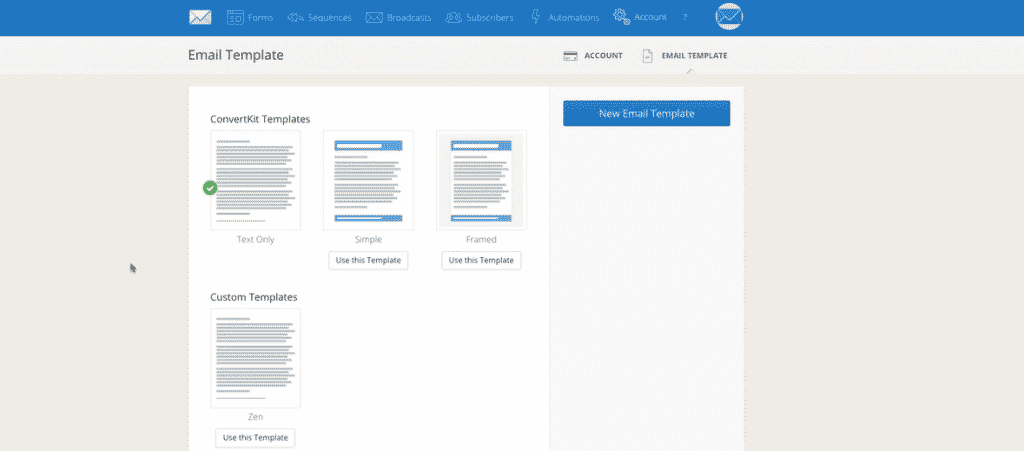
Need an email marketing solution for creatives that’s as budget-friendly as it is effective? Check out ConvertKit.
For just $15 per month (or $9 per month if you opt for an annual plan), you gain access to comprehensive marketing software that not only takes the hassle out of sending emails but also helps you create landing pages, market your products, and more.
8. MailerLite
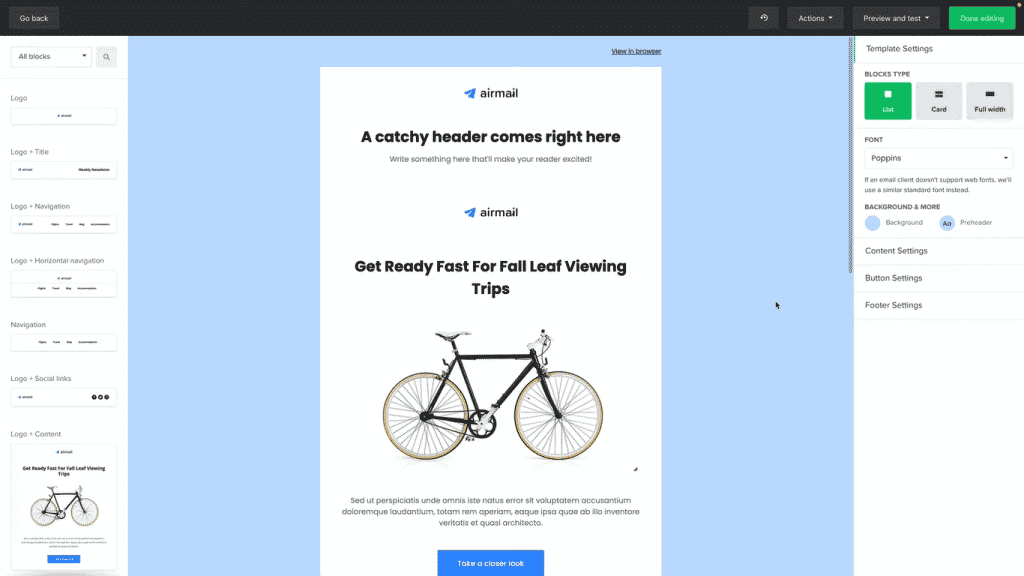
MailerLite is another customer-focused email marketing solution that’s very budget-conscious at only $10 per month (or $7 per month on an annual plan).
It’s appropriate for growth-oriented businesses and companies of all types — everything from brand new startups to bustling enterprise companies.
User-friendly editors, solid deliverability, intuitive analytics, and multiple features make it an excellent fit for solopreneurs and creatives, too.
9. GetResponse
If you run a small to mid-sized enterprise business (or handle email marketing strategy for one), you should definitely take a closer look at GetResponse. Pricing ranges from $0 for up to 500 contacts to just under $100 monthly for a fully equipped e-commerce package, so it’s affordable.
It also comes packed with user-friendly, dynamic features that make it easy to make your emails (and other messaging) your own. Picture options like autoresponders, AI-powered email generators, SMS marketing support, e-commerce support, and more!
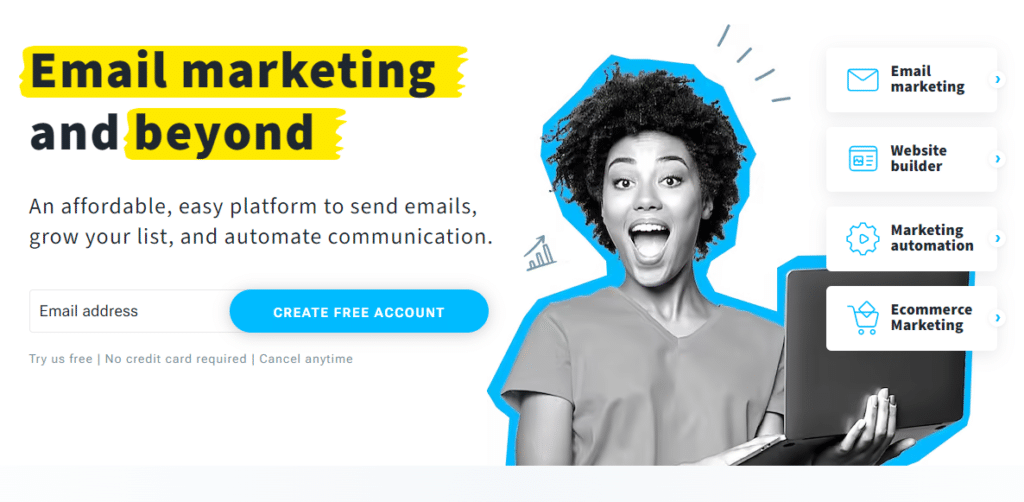
7 Email Marketing Metrics to Keep an Eye on
Now that we talked about how to plan an email marketing campaign and what tools can help you, we need to discuss the most important process to guarantee success when the strategy is being executed.
Yes, metrics and measuring performance. The data you gather from emails will help you tweak layouts, adjust the language, and create more efficient triggers.
Let’s see the 7 most relevant metrics you need to look at constantly.
1. Open rate
The percentage of recipients from the total emails sent that opened the message.
A bad performing open rate metric suggests that the subjects you wrote are not intriguing enough or that the mailing list is not well segmented.
2. Bounce rate
Email bouncing happens when the message is sent from the server but never reaches the recipient.
It can be caused by temporary problems (soft bounce) or if the address is invalid or non-existent (hard bounce).
When the bounce rate is too high, you should probably take a look at your email list.
Something may be wrong with how you are gathering leads, or there may be a performance problem with your email marketing solution.
3. Click-through rate
CTR is one of the most important metrics for your marketing campaign success.
It is the percentage of people who receive your email and not only open it but click on one or more links in the content.
A low performance here can indicate that your message is not clear or engaging enough.
It can also have something to do with how well you develop your CTAs. You have to be objective, charming, and convincing.
4. Conversion rate
Conversion goes beyond click-through, but it is not necessarily about buying something in this context.
It refers to the rate of people who performed the desired action in each email. It can be reading and responding to an article, filling out a form, or buying a product.
It is important to set goals for each message so you can track its efficiency in moving a lead forward.
5. Email forwarding rate
Sometimes an email has so good content that people just want to share it with family and friends.
Email marketing tools can measure that and point out those that were forwarded the most to other recipients. Learning from them will help you improve all your strategies.
6. Unsubscribe rate
If sharing shows that your content is doing well, the rate of people unsubscribing to your newsletter or choosing not to receive emails from you can be a bad sign.
Usually, the number grows when content is inconvenient or not useful.
If it happens, maybe, it is time to revise your strategy.
7. List growth rate
Sharing, engaging, and converting help you have a bigger email list to work with. More addresses, more leads. More leads, more sales.
This growth will show you how the company is performing overall in its email marketing strategy.
It also will tell a lot about how effective your content is in attracting new leads and nurturing them.
You may also be interested in these articles:
- Interactive Newsletter: The New Way to Capture Consumer Attention
- Get More Responses with These 8 Email Outreach Tips
- How Email Analytics Can Help Improve Your Campaigns
How to Measure the Results of Email Marketing Campaigns
Now that you know the metrics, it is necessary to understand that numbers are nothing by themselves.
A good analysis is always a combination of measurement and context.
So we want to end this conversation by proposing a reflection to you. It doesn’t matter if you have the best-designed plan and great content if they are just not suitable for your target audience, your budget, and your goals.
A company needs to be smart to make it in this digital era. It needs to gather as much data as possible and translate it into feasible actions — creating better content, tweaking triggers, and investing in lead acquisition.
In the end, the results of this campaign are measured from an ROI standpoint: how much you had to spend to reach the goals you wanted to achieve.
Email Retargeting: Reconnecting With Inactive Subscribers and Boosting Engagement
Remember, the average person on your email list may receive over a hundred emails daily. Almost no one who gets that many actually reads them all, and marketing emails are often the first to fall by the wayside.
This means every brand deals with inactive subscribers and needs a few go-to solutions for re-engaging them. Here are a few ideas to try.
Revisit your send times
According to Campaign Monitor, the highest average email open rates occur on Mondays, while the lowest are on Sundays. However, you’ll naturally want to compare those stats to your own data. The fresher an email, the more likely a person will check it out.
Offer special deals and incentives
Everyone loves a good deal, freebie, or discount. People love exclusive ones even more, so don’t be afraid to offer inactive subscribers something extra in exchange for re-engaging with you.
Ensure your list is properly segmented
The more relevant an email is to a recipient’s interests or life circumstances, the more likely they will want to engage with the sender further. If engagement is lagging across the board for you, it might be time to revisit your segmentation methods.
Offer an unsubscribe option
Although this might sound like the last thing you’d want to do to reactivate a customer, it’s more effective than you think. Sometimes, simply being asked nicely whether they’d like to stay on a mailing list is enough to remind the person of why they subscribed in the first place.
Email Campaign Case Studies: Real-Life Examples of Successful Email Marketing Strategies
Are you ready to see what a successful email marketing strategy in action looks like? Take a closer look at the following case studies, take notes, and get inspired.
Wok to Walk
Wok to Walk is an innovative U.S.-based health food company specializing in delicious products cooked fresh from local ingredients. They boosted their average email open rate by over 18 percent by revamping their subject lines to include a phone number. That got their target audience excited enough to really engage.
Mad Tasty
Mad Tasty, a beverage company specializing in hemp products, was one of many brands that survived the pandemic by experimenting and switching things up. Before the pandemic, they were still primarily an offline company. But they leveraged the power of email as a marketing channel to get their clientele to buy online instead.
Digital Marketer
Top-tier marketing blog Digital Marketer proved the importance of the right subject lines when they tripled their open rates by changing theirs. Some of their more successful subject lines promised to teach subscribers valuable, exclusive tips and techniques—proof positive that today’s consumers respond to helpful content.
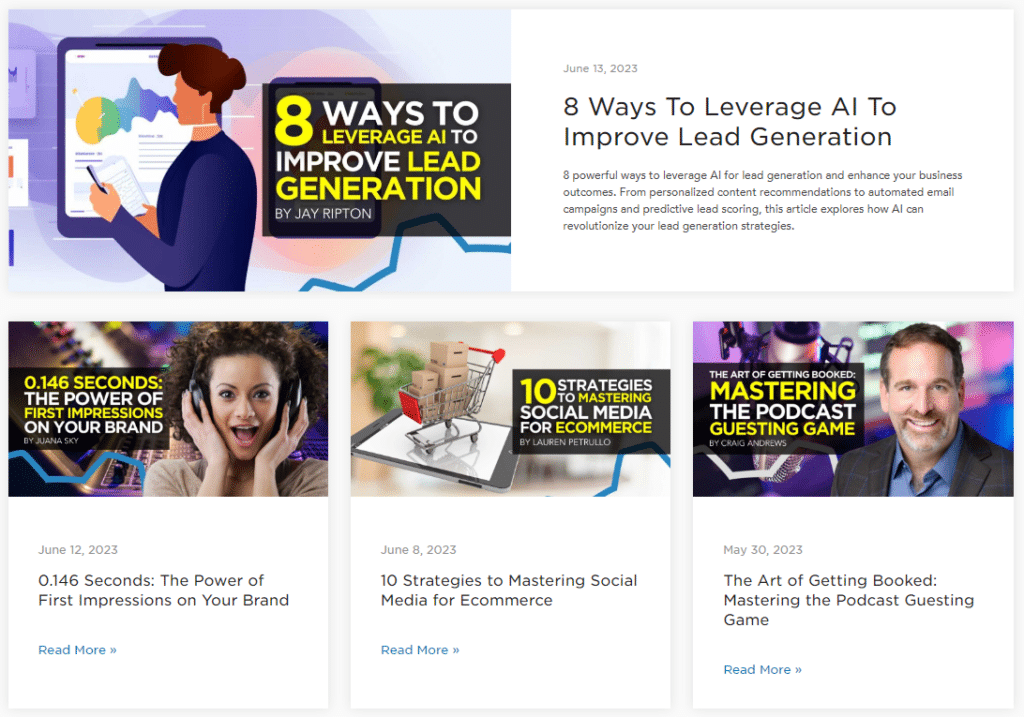
Email Marketing Trends for 2024: Emerging Strategies and Techniques to Stay Ahead
A good email marketing strategy is like any other component of a well-rounded digital marketing campaign. Consumer tastes and marketing trends constantly change, so staying ahead of the curve is essential. Here are some key trends to take advantage of in 2024 and beyond.
Leveraging user-generated content
Social proof is a powerful influence on consumers’ buying decisions, as consumers tend to trust other consumers. Many marketers are integrating user-generated content into their marketing emails to boost engagement.
AI-powered data analysis
AI-powered tech can be terrific for analyzing customer data and behavior patterns. Marketers are leveraging this tech to unearth valuable insights about their subscribers and maximize the effectiveness of their email strategies.
Dynamic interactive experiences
Interactivity has already been huge in marketing lately, and as of 2024, it’s officially found its way into email marketing. Interactive emails allow customers to take surveys, rate services, add items to carts, and more—all from within the email itself.
Wrap Up
Your brand’s email marketing strategy is one of your most significant assets for reaching your customers where they live and boosting conversions through the roof. However, getting results takes creativity, innovation, dedication, and lots of incredible content.
Take your email campaign to the next level when you assemble a team of expert content writers and marketing experts at WriterAccess. They’ll take the guesswork out of amazing content, subject lines, and CTAs that really sparkle.
Sign up for your free 14-day WriterAccess trial today, and experience the difference firsthand! You’ll be glad you did.









